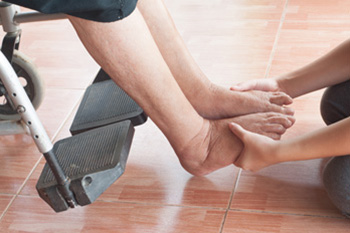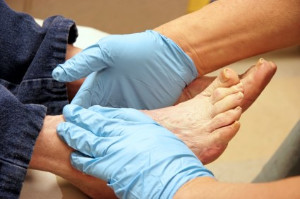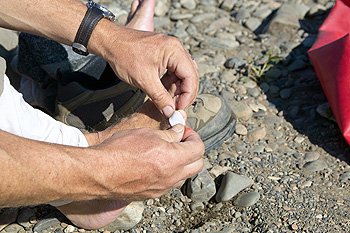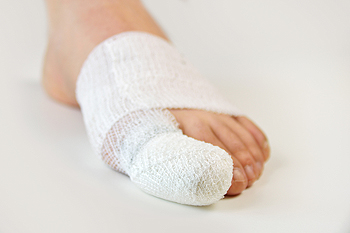
Foot problems are common among the elderly population and can lead to pain, discomfort, and an increased risk of falls. Conditions like achy heels often result from plantar fasciitis or heel spurs, causing stabbing pain that worsens with movement. Corns and calluses develop due to pressure and friction, making walking painful. Bunions, a bony bump at the base of the big toe, can distort foot shape and hinder balance. Hammertoes, where toes curl abnormally, can also limit mobility and cause pressure points. Toenail fungus, often overlooked, can thicken nails and make them difficult to trim, leading to infection and discomfort. Together, these issues not only impact daily activities but also increase the likelihood of falls, making regular foot care essential for seniors to maintain mobility and reduce their risk of injury. Wearing proper footwear and regular checkups with a podiatrist can help manage these conditions. If you are elderly and have any uncomfortable foot condition, it is suggested that you schedule regular appointments with a podiatrist for help in their management.
Proper foot care is something many older adults forget to consider. If you have any concerns about your feet and ankles, contact Howard Waxman, DPM from Pleasant Valley Podiatry. Our doctor can provide the care you need to keep you pain-free and on your feet.
The Elderly and Their Feet
As we age we start to notice many changes in our body, but the elder population may not notice them right away. Medical conditions may prevent the elderly to take notice of their foot health right away. Poor vision is a lead contributor to not taking action for the elderly.
Common Conditions
Susceptible Infections
Diabetes and poor circulation can cause general loss of sensitivity over the years, turning a simple cut into a serious issue.
If you have any questions please feel free to contact one of our offices located in Willoughby Hills and Broadview Heights, OH . We offer the newest diagnostic and treatment technologies for all your foot and ankle needs.

Foot problems are a common and serious concern for individuals with diabetes, often leading to complications like diabetic foot ulcers. Diabetes can cause nerve damage and poor blood circulation, making the feet more prone to injuries that might go unnoticed due to reduced sensation. The lack of feeling increases the risk of wounds, blisters, and ulcers, which can worsen without proper care. Diabetic foot ulcers can take a long time to heal and may lead to infections if not treated properly. Podiatrists play a vital role in managing diabetes related foot issues. They can perform necessary treatments, such as debridement to remove dead tissue, suggest appropriate footwear to alleviate pressure on affected areas, and provide wound care solutions. If you have a foot problem related to diabetes, it is suggested that you schedule an appointment with a podiatrist for regular monitoring and care.
Diabetic foot care is important in preventing foot ailments such as ulcers. If you are suffering from diabetes or have any other concerns about your feet, contact Howard Waxman, DPM from Pleasant Valley Podiatry. Our doctor can provide the care you need to keep you pain-free and on your feet.
Diabetic Foot Care
Diabetes affects millions of people every year. The condition can damage blood vessels in many parts of the body, especially the feet. Because of this, taking care of your feet is essential if you have diabetes, and having a podiatrist help monitor your foot health is highly recommended.
The Importance of Caring for Your Feet
Patients with diabetes should have their doctor monitor their blood levels, as blood sugar levels play such a huge role in diabetic care. Monitoring these levels on a regular basis is highly advised.
It is always best to inform your healthcare professional of any concerns you may have regarding your feet, especially for diabetic patients. Early treatment and routine foot examinations are keys to maintaining proper health, especially because severe complications can arise if proper treatment is not applied.
If you have any questions please feel free to contact one of our offices located in Willoughby Hills and Broadview Heights, OH . We offer the newest diagnostic and treatment technologies for all your foot and ankle needs.

Blisters on toes can arise from various causes, each affecting the foot differently. The most common trigger is friction from wearing ill-fitting shoes or repetitive rubbing, which can lead to clear blisters filled with fluid that cushions the damaged skin. Blood blisters occur when friction causes blood vessels to break beneath the skin, resulting in a darker, purplish blister. Infected blisters are more concerning, often developing from open sores or cuts that become contaminated with bacteria. These blisters may appear red, swollen, and filled with pus, indicating an infection. Wearing proper footwear, moisture-wicking socks, and prompt treatment of open blisters can help prevent these issues. If you notice blisters are frequently forming on your feet or toes, it is suggested that you consult a podiatrist who can determine what the cause is, and offer effective treatment and prevention techniques.
Blisters are prone to making everyday activities extremely uncomfortable. If your feet are hurting, contact Howard Waxman, DPM of Pleasant Valley Podiatry. Our doctor can provide the care you need to keep you pain-free and on your feet.
Foot Blisters
Foot blisters develop as a result of constantly wearing tight or ill-fitting footwear. This happens due to the constant rubbing from the shoe, which can often lead to pain.
What Are Foot Blisters?
A foot blister is a small fluid-filled pocket that forms on the upper-most layer of the skin. Blisters are filled with clear fluid and can lead to blood drainage or pus if the area becomes infected.
How Do Blisters Form?
Blisters on the feet are often the result of constant friction of skin and material, usually by shoe rubbing. Walking in sandals, boots, or shoes that don’t fit properly for long periods of time can result in a blister. Having consistent foot moisture and humidity can easily lead to blister formation.
Prevention & Treatment
It is important to properly care for the affected area in order to prevent infection and ease the pain. Do not lance the blister and use a Band-Aid to provide pain relief. Also, be sure to keep your feet dry and wear proper fitting shoes. If you see blood or pus in a blister, seek assistance from a podiatrist.
If you have any questions, please feel free to contact one of our offices located in Willoughby Hills and Broadview Heights, OH . We offer the newest diagnostic and treatment technologies for all your foot care needs.

Walking with a broken big toe can be incredibly painful and may hinder your daily activities. Despite the discomfort, many people continue to walk with a broken toe, which can lead to complications like improper healing or worsening the injury. While it is tempting to tough it out, seeking professional medical care is important. A podiatrist can assess the severity of the break, determine whether the bone is aligned, and suggest appropriate treatment. Depending on the injury, this may include buddy taping the toe to an adjacent one, using a splint, or even recommending a specialized shoe to reduce pressure. This may also help to protect the toe and allow proper healing. Ignoring a broken big toe can lead to chronic pain, deformities, or arthritis in the joint. Your podiatrist can provide guidance on when it is safe to resume normal activities to avoid re-injury. If you have a broken big toe, it is suggested that you schedule an appointment with a podiatrist for an exam and treatment.
Broken toes may cause a lot of pain and should be treated as soon as possible. If you have any concerns about your feet, contact Howard Waxman, DPM from Pleasant Valley Podiatry. Our doctor will treat your foot and ankle needs.
What Is a Broken Toe?
A broken toe occurs when one or more of the toe bones of the foot are broken after an injury. Injuries such as stubbing your toe or dropping a heavy object on it may cause a toe fracture.
Symptoms of a Broken Toe
Although the injured toe should be monitored daily, it is especially important to have a podiatrist look at your toe if you have severe symptoms. Some of these symptoms include worsening or new pain that is not relieved with medication, sores, redness, or open wounds near the toe.
If you have any questions, please feel free to contact one of our offices located in Willoughby Hills and Broadview Heights, OH . We offer the newest diagnostic and treatment technologies for all your foot care needs.